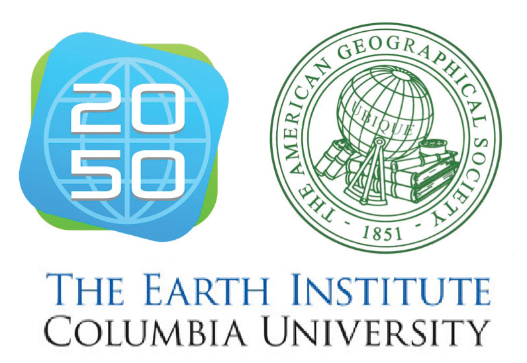AN EVENT OF THE AMERICAN GEOGRAPHICAL SOCIETY AND THE EARTH INSTITUTE
| Date: November 19th |
| Location: Low Memorial Library, Columbia University, 116th Street and Broadway, New York City, NY 10027 |
The world of 2050 will be radically different. It is not at all clear how we will get there from here and what we can do to navigate through the uncharted waters of the future. Climate change, urbanization, rapid expansion of the Internet and the availability and use of information, the continued evolution of human identity, and changing modes of commerce, cooperation, and conflict from local to global scales are just some of the many trends influencing the future. Each poses many challenges and opportunities for how we perceive and shape our world’s geography now and in coming decades.
To help lay the foundation for exploring these local, regional and global challenges—and the investments in technology, data, laws, policies, and capacities needed to improve our ability to navigate through them—the American Geographical Society is collaborating with the Earth Institute, Columbia University to organize an “Expedition to the Future.”
The one-day inaugural event, to be held at Columbia’s Low Library in Manhattan, offers an opportunity for thought leaders in industry, government, the social sector, and academe to come together to think about collectively exploring the future, and to examine how geography, geographic thinking, and geospatial data and technologies will enable this new age of exploration.
This inaugural event will focus the thought leaders in attendance on 6 major areas of focus. All seek to help us understand how our world will change geographically over time, and the challenges that these processes pose as we seek to navigate an uncertain future.
Populations, Shifting Identity, and Well Being
Over the next few decades, the geography of human populations will change materially. Urbanization will continue, and the concentration of people in coastal zones will increase. The geography of human well being will be re-written, as health and wealth shift radically. And, borders and sovereignty within borders will face and possibly succumb to new pressures as new social movements arise, reshaping identity.
Climate, Risk and Opportunity
The onslaught of climate change will result in increased volatility in weather patterns and the resulting natural hazards that will impact populations along the coasts, on islands, in river basins, and in inland agricultural areas. And the secular rise in sea level will only magnify the effects of these natural hazards. Additionally, climate change will fundamentally remap the Arctic, opening it up to intercontinental transportation, energy and mineral exploitation, and geopolitical competition.
The Future Energy Landscape
With huge changes in the geography of humanity, the future energy landscape will also change enormously.The geography of global energy demand will evolve as developing nations increase their energy consumption to present day first world patterns. The acceleration of renewable energy development will change the nature of energy dependency between different regions, and will change the landscapes on which we live. And, the emergence of new fossil fuel resources will fundamentally alter the global network of exploitation, distribution, processing, and consumption – re-writing power relationships across the globe.
The Emerging Geography of the Internet of Things
The Internet remapped the geography of human access to knowledge, and what it meant to be connected to the global society. The Internet’s initial geography, connecting government labs, agencies and universities has expanded to touch billions of computers and mobile devices, yet again remapping the distribution of societal capabilities. However, this geography is far from ubiquitous, and the spatial distribution of this digital divide materially shapes how societies can develop. The recent emergence of the Internet of Things promises to yet again reshape the geography of technical capability that societies have access to and can leverage to meet their goals.
The God’s Eye View
In the 20th Century, human society came to understand its world geographically through a technical lens. Satellite and airborne remote sensing transformed how we observed and understood our planet. The rise of the Internet and social media opened up wholly new ways of thinking about the geography of human expression and activity. And, as every living human becomes sophisticated, location-aware sensor, ground truth can be provided to validate broad-scoped change observed from above. How we understand our world’s geography in 2050 will be fundamentally different from our way of knowing our world only yesterday.
Investment, Law and Policy
In order to successfully navigate our way to this new future, deliberate action will be required in the realm’s of investment, legal and policy development. The ability to properly observe and anticipate changes to our world’s geography – at a local, regional and global scale – will require investment in new geospatial technologies, data, and methodologies. It will also require thoughtful engagement in legal and policy development (at local, national, and international levels) to ensure that these techniques and technologies are leveraged to meet societal goals, so they do not become technics out of control. Geography 2050 will not just happen. It will be the sum of many thoughtful, and perhaps thoughtless, actions by the private, public academic, and social sectors.







